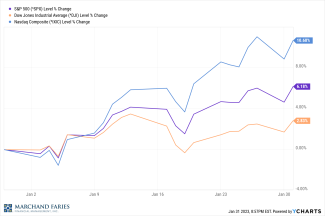
February 1, 2023
2023 is starting out with several positive tones.
A few supply chain constraints have diminished in late 2022, allowing retailers to shore up their inventories at a faster pace than originally expected. Inflationary pressures, although elevated, have decelerated on appliances, food, and energy. Housing, a major driver of inflation last year, has also slowed with higher mortgage rates deterring both home builders and home buyers. We are expecting this trend to continue through 2023 where we may actually see negative housing growth in the latter half of 2023.
The three big factors keeping the economy humming have been jobs, consumer spending and business investment which has remained strong through 2022. However, with upcoming layoffs in 2023 will likely add to the bottom-line profits of many corporations. Unemployment is a lagging indicator of a strong economy since companies tend to cut jobs after lower sales, not in anticipation of them.
There are indications that the Federal Reserve rate hikes have had an impact on the economy with the rate of inflation declining over the past few months. Consumers have kept up spending by dipping into savings, but this action is unsustainable for an extended period and will help to cool the economy.
With the midterm elections behind us, we expect there to be a certain degree of gridlock in Washington, which is often good for Wall Street in that the rate of regulation slows considerably. International trade, both exports and imports, will most likely decline as many domestic manufacturing businesses have built up inventories and the strong dollar hurts exports to US trading partners.
January saw positive returns for all the major indices with the Dow, S&P 500 and NASDAQ starting the year at 2.83%, 6.18%, and 10.68% respectively, with the 10-year Treasury yielding 3.52%.

